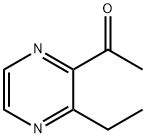2,3-Diethylpyrazine
Synonym(s):Shoyu pyrazine
- CAS NO.:15707-24-1
- Empirical Formula: C8H12N2
- Molecular Weight: 136.19
- MDL number: MFCD00006151
- EINECS: 239-800-1
- SAFETY DATA SHEET (SDS)
- Update Date: 2024-12-18 14:07:02

What is 2,3-Diethylpyrazine?
Chemical properties
CLEAR COLORLESS TO LIGHT YELLOW LIQUID
Chemical properties
2,3-Diethylpyrazine has a nutty, hazelnut aroma
Occurrence
Reported found in baked potato, mushrooms, cocoa, roasted filberts, malt and shoyu (fermented soya hydrolysate).
The Uses of 2,3-Diethylpyrazine
2,3-Diethylpyrazine is used in method for preparing coffee extracts for cigarette using aroma backfilling agents.
Preparation
By condensation of 3,4-hexanedione with ethylenediamine
Definition
ChEBI: 2,3-Diethylpyrazine is a member of pyrazines.
Taste threshold values
Taste characteristics at 10 ppm: musty, raw, slight nutty, slight radishEMA PADI: 0.681 m
General Description
2,3-Diethylpyrazine is naturally present in tobacco and has been added to tobacco as flavor ingredients. Interaction of 2,3-diethylpyrazine (a volatile flavor compound) with propyl gallate has been investigated.
Properties of 2,3-Diethylpyrazine
| Boiling point: | 180-182 °C (lit.) |
| Density | 0.963 g/mL at 25 °C (lit.) |
| refractive index | n |
| FEMA | 3136 | 2,3-DIETHYLPYRAZINE |
| Flash point: | 159 °F |
| storage temp. | Inert atmosphere,Room Temperature |
| form | neat |
| pka | 2.16±0.10(Predicted) |
| Specific Gravity | 0.963 |
| color | Colorless to Light yellow |
| Odor | at 0.10 % in dipropylene glycol. raw nutty green pepper |
| JECFA Number | 771 |
| CAS DataBase Reference | 15707-24-1(CAS DataBase Reference) |
| NIST Chemistry Reference | 2,3-Diethylpyrazine(15707-24-1) |
| EPA Substance Registry System | Pyrazine, 2,3-diethyl- (15707-24-1) |
Safety information for 2,3-Diethylpyrazine
| Signal word | Danger |
| Pictogram(s) |
 Corrosion Corrosives GHS05  Exclamation Mark Irritant GHS07 |
| GHS Hazard Statements |
H315:Skin corrosion/irritation H318:Serious eye damage/eye irritation H335:Specific target organ toxicity, single exposure;Respiratory tract irritation |
| Precautionary Statement Codes |
P261:Avoid breathing dust/fume/gas/mist/vapours/spray. P280:Wear protective gloves/protective clothing/eye protection/face protection. P305+P351+P338:IF IN EYES: Rinse cautiously with water for several minutes. Remove contact lenses, if present and easy to do. Continuerinsing. |
Computed Descriptors for 2,3-Diethylpyrazine
New Products
Tert-butyl bis(2-chloroethyl)carbamate 4-Methylphenylacetic acid N-Boc-D-alaninol N-BOC-D/L-ALANINOL 3-Morpholino-1-(4-nitrophenyl)-5,6-dihydropyridin- 2(1H)-one Furan-2,5-Dicarboxylic Acid Tropic acid 1,1’-CARBONYLDIIMIDAZOLE DIETHYL AMINOMALONATE HYDROCHLORIDE R-2-BENZYLOXY PROPIONIC ACID 1,1’-CARBONYLDI (1,2-4 TRIAZOLE) N-METHYL INDAZOLE-3-CARBOXYLIC ACID (2-Hydroxyphenyl)acetonitrile 4-Bromopyrazole 5-BROMO-2CYANO PYRIDINE 5,6-Dimethoxyindanone 5-broMo-2-chloro-N-cyclopentylpyriMidin-4-aMine 2-(Cyanocyclohexyl)acetic acid 4-methoxy-3,5-dinitropyridine 2-aminopropyl benzoate hydrochloride 1-(4-(aminomethyl)benzyl)urea hydrochloride diethyl 2-(2-((tertbutoxycarbonyl)amino) ethyl)malonate tert-butyl 4- (ureidomethyl)benzylcarbamate Ethyl-2-chloro((4-methoxyphenyl)hydrazono)acetateRelated products of tetrahydrofuran







![METHYL 4-[(2,3-DIETHYL-6-QUINOXALINYL)OXY]BENZENECARBOXYLATE](https://img.chemicalbook.in/StructureFile/ChemBookStructure6/GIF/CB3689017.gif)
You may like
-
 2,3-Diethylpyrazine CAS 15707-24-1View Details
2,3-Diethylpyrazine CAS 15707-24-1View Details
15707-24-1 -
 2,3-Diethylpyrazine CAS 15707-24-1View Details
2,3-Diethylpyrazine CAS 15707-24-1View Details
15707-24-1 -
 1975-50-4 98%View Details
1975-50-4 98%View Details
1975-50-4 -
 2-HYDROXY BENZYL ALCOHOL 98%View Details
2-HYDROXY BENZYL ALCOHOL 98%View Details
90-01-7 -
 2-Chloro-1,3-Bis(Dimethylamino)Trimethinium Hexafluorophosphate 221615-75-4 98%View Details
2-Chloro-1,3-Bis(Dimethylamino)Trimethinium Hexafluorophosphate 221615-75-4 98%View Details
221615-75-4 -
 14714-50-2 (2-Hydroxyphenyl)acetonitrile 98+View Details
14714-50-2 (2-Hydroxyphenyl)acetonitrile 98+View Details
14714-50-2 -
 118753-70-1 98+View Details
118753-70-1 98+View Details
118753-70-1 -
 733039-20-8 5-broMo-2-chloro-N-cyclopentylpyriMidin-4-aMine 98+View Details
733039-20-8 5-broMo-2-chloro-N-cyclopentylpyriMidin-4-aMine 98+View Details
733039-20-8
Statement: All products displayed on this website are only used for non medical purposes such as industrial applications or scientific research, and cannot be used for clinical diagnosis or treatment of humans or animals. They are not medicinal or edible.